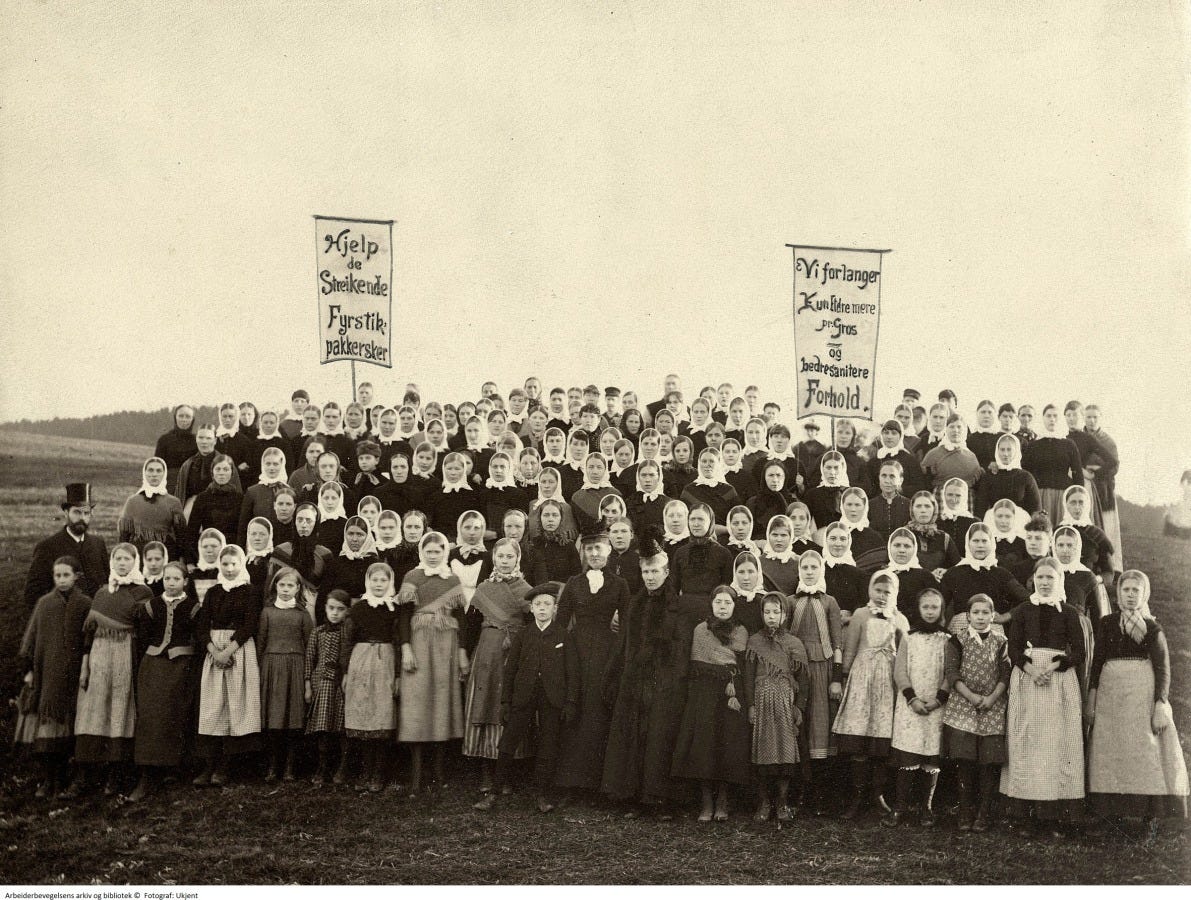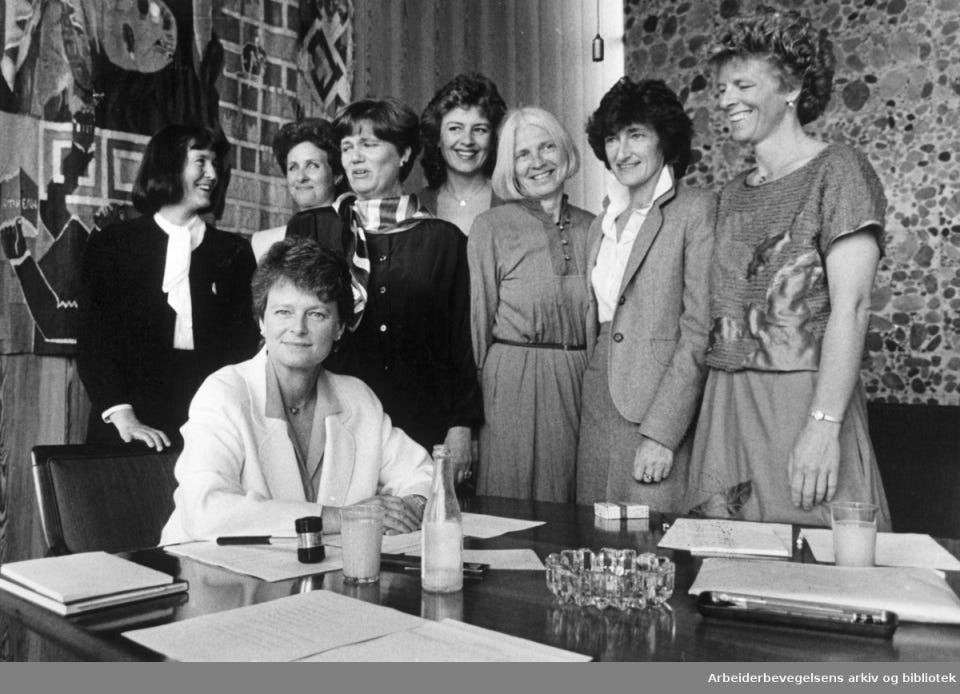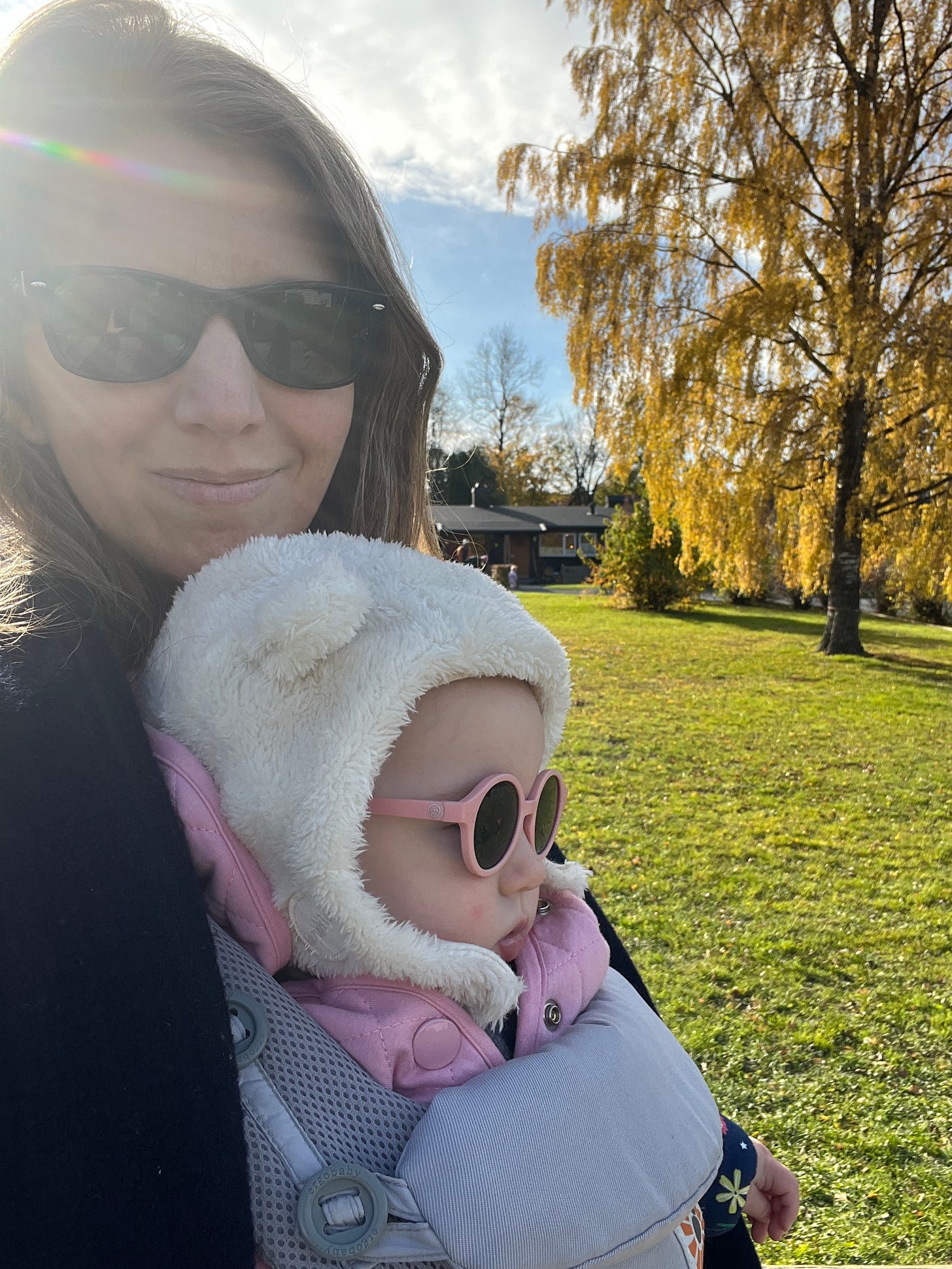A very brief history of paid parental leave in Norway
And why global and historical context matters in America's fight for national paid leave.
I’m an American who has lived in Norway for 11 years, and I’ve been a parent here for the past six years. In this newsletter, I write a lot about family policy – specifically, the family policies that we have here in Norway, and the ones we do not have in the United States.
First, some context. In the United States there is not, and has never been, any national mandate for employers to provide paid leave for their employees when they have a new baby. The U.S. is one of only seven countries in the world (and the only wealthy, industrialized one) that doesn’t guarantee paid leave to either parents.

The closest existing federal legislation is FMLA (the Family Medical Leave Act), signed into law in 1993 by Bill Clinton. It provides an annual 12 weeks of job-protected unpaid leave, and can be used for situations like illness, caring for sick or elderly family members, or caring for babies and children.
But, crucially, since it’s only accessible to workers in companies with over 50 employees and those who work a certain number of hours, only about 56% of Americans actually have this right. In 2021, Joe Biden’s Build Back Better plan (which also included investments in childcare and pre-kindergarten) first proposed offering 12 weeks of paid family and medical leave, which was then brought down to a proposal of four weeks, and then abandoned when every House Republican and one key Democrat failed to support the proposed legislation.
Today, some states (13 in total, plus Washington, D.C.) have created their own legislation for residents’ universal access to paid leave, including California (12 weeks with 60-70% wage replacement), and Washington State, which also offers 12 weeks of paid leave, including an extra four weeks for pregnancy complications.
Some employers offer paid leave, sometimes as an outright benefit or as disability insurance, but only about 27% of workers have access to employer-sponsored paid leave, and only 40% have access to short-term disability insurance. Often, any paid leave that is available is a patchwork of different options, which is a complex logistical maze for new parents-to-be.
Because paid leave is so inaccessible for so many, 1 in 4 American women return to work within two weeks of giving birth. These terrible conditions for new mothers contribute to a maternal mental health crisis, and (as a wealthy nation) a higher-than-average maternal mortality rate, especially for Black women. The World Health Organization recommends a minimum of 16 weeks of paid leave for new mothers. America’s “system” for parental leave is obviously a confusing, inequitable, and dangerous mess.
Many American parents – including a lot of my friends and family back home – talk about how it seems so much “better” to be a parent in other countries. But “better” how, specifically? What are the origins of a family-friendly society, what what will it finally take to get the United States on that path?
Other Americans hear about family policies abroad and assume that “the government is raising their kids”. Or that since we pay (slightly) higher taxes in countries like Norway with broad social welfare systems, “someone else” must be paying for it, creating a culture of entitlement, and killing work ethic. Or, that these issues should be left up to the family and not the government.
In the case of Norway, some assumptions I’ve heard a lot are that our government is only able to provide this kind of support because we are a 1) small, culturally homogeneous country or, 2) because of our nation’s oil wealth – without understanding that many of Norway’s social welfare policies, along with its strong culture for labor unions and workers’ rights, were established long before Norway discovered oil in the North Sea in the late 1960s.
In the United States, across this spectrum of ideas and beliefs about parenthood abroad, the collective conclusion tends to be that these types of family policies – national paid parental leave, universally subsidized daycare and preschool, free maternal and child healthcare, and child subsidy payments – could never work in America. People argue that the country is “too big and diverse” for these policies to meet everyone’s needs, that capitalist individualism runs too deep in our national bloodstream, or that we’re too politically divided to ever agree on a functioning system.
Much of this, I believe, stems from misunderstanding and misinformation about how family policy actually works in other places – which yes, includes other very large and diverse countries — and how long it’s been in place in the majority of the industralized world, which in most cases is many, many decades.
Globally, the average amount of paid leave is 29 weeks for mothers and 16 weeks for fathers, according to data from the World Policy Analysis Center. Because let’s be clear: structural support though specific family policies, including national paid leave, is happening right now in nearly every other country on earth. America just keeps making up excuses as to why it is, once again, the exception.
The reasons I started this newsletter are this: to dispel myths about the culture and politics of parenthood abroad, to provide insights into my lived experience as a middle-class parent in Norway, and to get specific about the effects of good family policy, both for individuals and society.
So, let’s get specific! I’m no expert on public policy (yet!). But I wanted to learn more about the origins and development of one of Norway’s best and most well-established family policies: paid parental leave. In doing so, I discovered a fascinating history that illustrates how establishing just one small policy can spark political momentum that builds across time, shifting gender roles, changing work culture, and the evolution of family life.
Here is a (very) brief history of parental leave in Norway:
1892
A law was created to address the needs of women who had entered the workforce during a time of broad industrialization. The law affected only wage-earning workers in factories, stating that women were prohibited from working during the first six weeks after giving birth. (With a doctor’s note that the mother and baby were healthy, they could return to work after four weeks.) In Norway, such as in other Nordic countries around the turn of the century, this law was largely meant to help combat infant mortality.
This is of course not so much a “maternity leave” as it is a gender-discriminatory mandate, since it did not apply to men, and new mothers were losing wages during this time. The law also did not protect them from termination from employment.
But…it was 1892! While this model was far from ideal, it is worth noting that 133 years ago, many working-class Norwegian women had a similar level of accessibility to unpaid family leave as many Americans do today.

1909
Women working in factories were granted a small financial compensation during their maternity leave. Also, while it isn’t specifically related to paid parental leave, it’s worth noting that in 1915 a law was passed stating that employers could not deny women the right to breastfeed their babies during working hours. By 1936 it was common (though not legally mandated) to provide women working with two 30-minute breaks per day for breastfeeding.
1936
Starting in this year, most working women were protected from dismissal when they gave birth, and were granted the right to paid maternity leave during the six weeks before giving birth, and the first six weeks after.
Throughout the 1930s, maternity leave in the Nordic countries was discussed and debated by governments, particularly regarding the issue of population decline. Some believed that women’s newfound access to the labor market was to blame for the decrease in births, and that policies like paid maternity should be scrapped because they might keep women in the workforce when they should be at home making more babies. (Whoa, sounds familiar, huh?)
However, this debate was interrupted due to the start of WWII. Norway was invaded by Nazi Germany in April 1940 and occupied until May 1945. From the postwar period through the mid-1960s, Norway had a culture for housewives much like in the United States. This meant that there was more stay-at-home mothers, and more focus on the new nuclear family.
1946
Though not directly related to paid leave, this was the year that barnetrygd (the “child security” benefit) was established. The momentum for this policy had been building in the form of multiple proposals starting as early as 1919. Once passed in 1946, single mothers and mothers on disability received it as a payment starting with their first child. All other families received it starting with their second child, which at the time was 180 kroner per year. These payments were universal, and paid out directly to the mother, regardless of the family’s income (this is still true today). Now, we receive it as a monthly payment of 1766 kroner ($161) per child for kids under age 6. Ages 6-18, it’s 1510 kroner ($141) per month.
1956
Norway establishes a law guaranteeing gainfully employed women the right to 10 weeks paid maternity leave, though it still doesn’t guarantee job protection. The engangsstønad (“one-time child support”) was also introduced, which is a one-time pay-out given to women after giving birth who are unemployed, and therefore don’t have rights to paid maternity leave. The amount paid out at the time was 150 kroner ($15). In 2025, it’s 92 648 kroner (about $8,500).
1971
National paid maternity leave is extended to 12 weeks.
1977
Norwegian law now states that all employers must allow 18 weeks of paid, job-protected parental leave. The first 6 weeks must be used by the mother, and the remaining 12 weeks can be split between the parents as desired. Meaning that at this time, fathers finally entered paid leave policy. In addition, the legislation now stated that men must be given the right to stay home during the first two weeks after their partner has given birth, with any financial compensation to be decided by their employer. The Labor Party was in power at the time.
1987
National paid leave is raised to 20 weeks; 6 weeks must go to the mother, the other 14 can be split between parents.
1988
Raised to 22 weeks.
1989
Raised to 24 weeks. In this year, Norway introduced the option for parents to take a longer leave at less pay. They now had the right to take 24 weeks total (between them, with 6 weeks reserved for the mother) at 100% of their respective salaries, or 30 weeks total, while receiving 80% of their respective salaries.
1990
Raised to 28 weeks at 100% pay, with the option of taking 35 weeks at 80% pay.
1991
The proposal for a “father quota” for paid leave was first raised, with Jens Stoltenberg from the Labour Party as the chair of the commission on this issue. Stoltenberg would go on to become Prime Minister 2000–2001 and 2005–2013, and the NATO Secretary General from 2014-2025.
1992
Paid leave is raised to 35 weeks at 100% pay, or 44 weeks at 80% pay. Women also now have the right to start their paid maternity leave 2 weeks before their due date.
1993
Women have the right to start their paid maternity leave 3 weeks before their due date. In this same year, Norwegian men were granted the right to 4 weeks of paid paternity leave that could not be transferred to the mother, aka the “father quota.” In other words, if the father didn’t take his leave, the family would lose those weeks of leave altogether.
This “use or it lose it” father quota was implemented as a way to improve gender equality by ensuring that fathers were also participating in childcare – or at least, that they had the opportunity to do so without losing income. This particular policy came into place during the third term of Norway’s first woman prime minister, Gro Harlem Brundtland. Brundtland served three terms, in 1981, 1986-1989, and 1990-1996.

1998
Kontantstøtte, the “cash for care” benefit was implemented, which still exists today. This provides a small amount of financial compensation for parents who choose not to send their children to the public daycare (or haven’t yet gotten a spot), and applies for parents of toddlers ages 13-19 months. This money can cover lost income while taking unpaid leave to provide child care, or pay for other types of care, like a nanny. Today, the amount is 7500 kroner ($680) per month and is not taxed.
2005
Paid leave is raised to 43 weeks at 100% pay or 53 weeks at 80% pay. The “father quota” is raised to 5 weeks.
2006
44 weeks at 100% pay or 54 at 80% pay. The “father quota” is raised to 6 weeks.
2009
46 weeks at 100% pay or 56 weeks at 80% pay. The “father quota” is raised to 10 weeks.
2011
47 weeks at 100% pay or 57 weeks at 80% pay. The “father quota” is raised to 12 weeks.
2013
49 weeks at 100% pay or 59 weeks at 100% pay. The “father quota” is raised to 14 weeks.
2014
The “father quota” is lowered to 10 weeks by the government led by Høyre (the conservative party). Erna Solberg, Norway’s second woman prime minister, led the party at the time.
2018
The “father quota” is raised to 15 weeks, with the total number of weeks remaining unchanged. This was done in an effort to encourage more fathers to participate in child care and improve gender equality for women in the workforce. Parents are allowed to take out all of their leave at once, or combine it with work and/or vacation. In other words, it’s allowed to go back to work part time while also being on partial paid leave. The paid leave must be used by the time the child turns 3, or before a new baby is born. Solberg was still in power at the time.
2025
The paid parental leave system continues to work the same way as per the changes made in 2018, as follows: for 100% income replacement (which is capped at a certain amount), parents can take 49 weeks, with 15 weeks (+ 3 before birth) earmarked to the mother/birthing partner, 15 weeks ear-marked to the father/non-birthing partner, and 16 weeks shared, which they can distribute between them as desired. For the 80% pay option, it’s 61 weeks total/19+3 to the mother, 19 to the father, and 18 shared. In addition, fathers are given two separate weeks of paid leave at the time of birth.

In a follow-up post, I will outline more specifics about our modern system, including: how we pay for it, how much we can earn during paid leave, who has access, how flexible it is, how long you need to have worked and/or lived in Norway, and insight into some of the discourse and debates around the current system.
It’s not perfect, and is always under development and up for critique. But, although there are debates around the details, there is never any question of the critical need for these policies. Paid parental leave is a cornerstone of Norwegian society and family life, as it is in so many other countries.
I believe that the more we keep these issues at the forefront of our American political discourse, the more likely we are to affect real change. And the more specific we can get about what kind of national-level support parents need, and what that could look like in America, the more we (and policymakers) can start building this kind of history in United States, too.
Things may seem bleak now, but unlike almost every other issue, bipartisan support for federal paid leave does exist. I know that passing it can and will happen in the United States. But not without a fight.
Sources:
Den Store Norske Leksikon: Kvinners rettigheter i Norge fra 1945 til 1990-årene
Den Store Norske Leksikon: Barnetrygd
NAV (Arbeids- og velferdsforvaltningen)
Mundheim, Vilja. “The Changes in the Parental Leave Policy in Norway 2018/2019: Policy Discourse and Gender Equality.” 2020.
Valdimarsdóttir, Fríða Rós. “Nordic experiences with parental leave and its impact on equality between women and men.” 2006.
“The U.S. was close to universal paid leave. With the collapse of Build Back Better, it’s all fallen apart.” The 19th. December 20, 2021.
“The World ‘Has Found a Way to Do This’: The U.S. Lags on Paid Leave.” New York Times. October 25, 2021.





Why are we like this? I’m moving!🇳🇴
Never have seen a better and consistent plan to care for moms, infants, and children. Papa leave is a great example of how to include fathers in bonding with their babies, older kids, and spouses. Thanks for a well written article, Ariana!